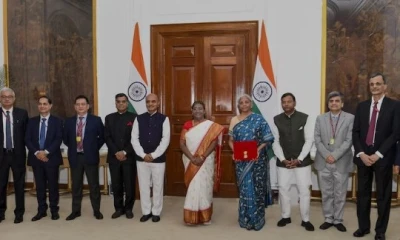Union Finance Minister Nirmala Sitharaman has begun presentation of the Interim Budget of the current financial year in Parliament’s joint session. The infrastructure outlay has been raised to Rs 11.11 lakh crore in FY25. Additionally, some of the significant issues such as controlling capital expenditure to regulate fiscal deficit, cutting subsidies, pivotal welfare measures for women, farmers, the impoverished, and youth as directed by Prime Minister Narendra Modi will ne addressed.
1. Significant Groups
Ahead of the Budget Session, Sitharaman mentioned these targeted groups will be uplifted without considering their caste, community or religion and measures will taken akin to the previous budgets.
2. Skill Development Programmes For Youth
The Centre, reportedly, will raise the present allocation of Rs 2,278 crore for the Skill India programme launched to enhance workers’ skills. Other programme to offer free short-duration skill training, monetary rewards and skill certification is the Pradhan Mantri Kaushal Vikas Yojana or PMKVY for youth.
3. Informal Sector
Bharat’s informal sector, considered as the foundation of economic activity, will be supported with the required policy and credit accessibility facilitating its operations along with its own growth probability. Additionally, the Central Government will announce a special package for the MSME sector facilitating more access to institutional credit at competitive rates.
DBS Bank India Executive Director and Head Sudarshan Chari asserted inclusion of all MSMEs on Udyam will be pivotal for accessing formal credit channels and government incentives and schemes.
Additionally, the Interim Budget is likely to pave new avenues for SMEs as Open Network for Digital Commerce or ONDC has leveraged integration of SMEs from Tier 2 and 3 cities into the digital marketplace.
4. Fiscal Deficit
The Centre aims to lessen its fiscal deficit from the budgeted 5.9 per cent to 4.5 per cent of the GDP by the Financial Year 2026 without compromising on judicious social welfare spending. Moreover, the Finance Minister mentioned the “macro-economic fundamentals are fine” and the Indian economy is “moving in the right direction”.
ICRA economists anticipate the fiscal deficit target for FY25 to be pegged at 5.3 per cent of the GDP, midway through the expected print of 6.0 per cent for FY2024 and the medium-term target of sub-4.5 per cent by FY26. Bharat has set a target of a 5.9 per cent fiscal deficit for FY24.
5. Capex Growth
The Centre’s strategies on public capex spending will be important factor of focus owing to its role in impacting the economic growth and broad-based revival in private sector capex. The focus on public capex is to address Bharat’s considerable infrastructure deficit and to make it a substitute for lacklustre private capex, feel the Nomura analysts.
The CII advised the government to raise its capital expenditure by 20 per cent to Rs 12 lakh crore, which will be less as compared to the last two years.
FM Sitharaman’s Attire
Other than budget presentation, Finance Minister Nirmala Sitharaman has always garnered attention for the choice of attire. It is significant as she is popular for endorsing Indian textiles and vocal for local message. This time she looks adorable in a blue and cream-coloured tussar saree filled with cream-coloured kantha works.
FM Sitharaman is also known for constantly carrying the red book, a stylistic statement and a traditional bahi khata in her maiden budget in 2019. The budget became paperless with the red-cover tablet from 2021.

















